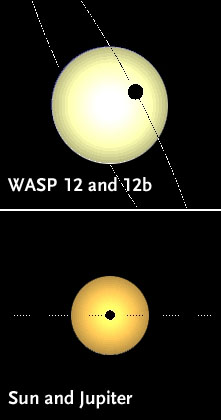Oh, how blasé we've become. Fifteen years ago the discovery of a planet around another star would have been front-page news.
Now the exoplanet tally stands at 334 — with more than 60 of those found this past year alone. To make the news these days, an alien world must either have something in common with Earth (such as water) or be truly bizarre.

The newly discovered exoplanet WASP-12b is, like the similar world WASP-3b depicted here, orbits very close to its host star and therefore is incredibly hot.
Instituto de Astrofísica de Canarias
So let me introduce you to WASP-12b, the place to go to ward off winter's chill. Discovered earlier this year by the Super Wide-Angle Search for Planets (SuperWASP), this orb has 1.4 times the mass of Jupiter.
But Jupiter-mass exoplanets are as common as Fisher Space Pens at an astronaut reunion. So what's special about this one? Two things.
First, it orbits so close to the host star (0.023 astronomical unit, or about 2 million miles) that it takes just 26 hours to complete one revolution. When exoplanets circle this tightly, they often appear to pass in front of and behind their host stars, and that's precisely how WASP-12b was discovered.

The star designated WASP-12, depicted in the upper panel, is tightly encircled by a large planet (black dot) that passes in front of and behind it. The planet has a diameter roughly 80% larger than that of Jupiter, seen projected against the Sun in the lower panel.
Iain McDonald / WASP team
Second, the planet has a diameter 1.79 times that of Jupiter. Run the numbers, and you'll deduce that WASP-12b has a mean density of just 0.3 g/cm3. Now, astronomers are fairly certain that WASP-12b is not a solid sphere of bamboo 160,000 miles across. But they are at a loss to explain why it's so big.
The 12th-magnitude host star, situated some 670 light-years away in southeastern Auriga, is a luminous F dwarf that scalds WASP-12b with light 6,600 times more intense than we get here on Earth. So its cloud-top temperature must be in the vicinity of 2,500 kelvins (nearly 4,600°F).
Simulations suggest that the intense heat should keep the planet puffed up a bit — but nothing like what's observed. So the discovery team, led by Leslie Hebb (University of St. Andrews, Scotland), suspects that the planet is shrouded in energy-absorbing hazes consisting of titanium and vanadium oxides, among the few things that are solid at those temperatures. The exotic dust might be absorbing enough light and heat to puff out the planet's outer layer.
Hebb and her colleagues explore this possibility in a paper to appear in the Astrophysical Journal.
In the meantime, they can claim bragging rights for having found the exoplanet with the largest known diameter (among those that transit), the hottest surface, and the shortest orbital period.
 3
3
Comments
Rod
December 23, 2008 at 6:22 pm
This exoplanet is racing around its host star. For a class F main sequence star, the host stellar mass could be about 1.4 solar masses. WASP-12b has an orbit with the semimajor axis near 0.023 AU according to the report. Its average orbital velocity could be some 232 kilometers per second compared to the Earth which is near 30 kilometers per second. Did this hot Jupiter initially form much farther out in an accretion disk, only later to migrate inward and stop very close to its host star? Clearly efforts to reconstruct such a past orbital history appear tricky to explain the origin of this system. If WASP-12b formed in situ (i.e. it experienced little or no inward migration), the presence of hot jupiters could suggest an abrupt and rapid formation process for many stars in the beginning.
You must be logged in to post a comment.
douglas simpson
December 28, 2008 at 8:00 pm
If one were to use only our solar system as a model, one would assume that it is logical for large gaseous bodies to form in the farther reaches of a solar system while the denser silicate bodies tend to form inward. But it seems that the more extra solar planets are discovered, the more the larger gaseous bodies seem to be close (even very close) to their host stars. I know we are currently hobbled by the fact that the methods used to detect extra-solar planets lend themselves to the detection of larger bodies, but most Jupiter class planets seem to be found much closer inward than than those in our system. I have often wondered if larger gaseous bodies tended to form close to the host star and later were "drawn" outward by means such as a second star in the system or the passing of a rouge star. Astronomers tell us that binary (and multi) systems are more common than single star systems. The gravitational forces inside such systems would be complex at best and the opportunity for migration of planets would be great IMO. We might have to rethink our current models of planetary formation.
You must be logged in to post a comment.
Rod
December 29, 2008 at 10:53 am
Note this comment on hot jupiters forming so close to their host stars when they were initially reported some 10 years ago - "The Doppler method of detection favors discovery of massive planets that are close to their companion stars. Extrasolar planets with masses 0.5 Mj and 3.7 Mj, respectively, have been reported to exist around 51 Pegasi and t Bootis. The inferred distances of these planets from their central stars are only about 0.05 AU. Since it is clearly impossible for gaseous planets to form this close to their central stars, it has been suggested that these planets migrated inwards from their sites of formation."[1]
I suspect comments like this may be driven by certain philosophical views on origins vs. the observations. The interpretation that these gaseous giant exoplanets formed in situ, challenges the assumption of uniformitarianism in science. This approach is unpalatable to many because it clashes with an evolutionary universe and could suggest abrupt, rapid formation (i.e. creation).
Reference
1.Rose, W.K., Advanced Stellar Astrophysics, Cambridge University Press, 1998, p. 33.
You must be logged in to post a comment.
You must be logged in to post a comment.